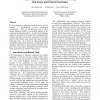Free Online Productivity Tools
i2Speak
i2Symbol
i2OCR
iTex2Img
iWeb2Print
iWeb2Shot
i2Type
iPdf2Split
iPdf2Merge
i2Bopomofo
i2Arabic
i2Style
i2Image
i2PDF
iLatex2Rtf
Sci2ools
ICRA
1999
IEEE
1999
IEEE
Rapid Physics-Based Rough-Terrain Rover Planning with Sensor and Control Uncertainty
In future planetary exploration missions, rovers will be required to autonomously traverse challenging environments. Much of the previous work in robot motion planning cannot be successfully applied to the rough-terrain planning problem. A model-based planning method is presented in this paper that is computationally efficient and takes into account uncertainty in the robot model, terrain model, range sensor data, and rover pathfollowing errors. It is based on rapid path planning through the visible terrain map with a simple graph-search algorithm, followed by a physics-based evaluation of the path with a rover model. Simulation results are presented which demonstrate the method's effectiveness.
| Added | 03 Aug 2010 |
| Updated | 03 Aug 2010 |
| Type | Conference |
| Year | 1999 |
| Where | ICRA |
| Authors | Karl Iagnemma, Frank Génot, Steven Dubowsky |
Comments (0)

